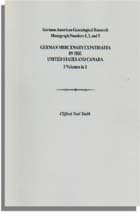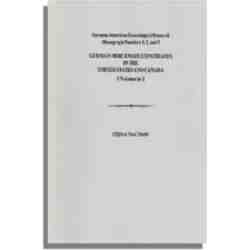It is commonly overlooked that the American Revolution witnessed one of the larger waves of German arrivals in the Americas up to that time. Unlike earlier streams of immigrants, the nearly 30,000 Germans who arrived at America’s shores between 1776 and 1783 were not farmers, craftsmen, or merchants; rather, they were mercenary soldiers dispatched to fi ght, for the most part, in support of George III’s goal of stemming the tide of the Revolution. (Civilian immigration to the Americas during this period ceased owing to British control of the high seas.)
Despite their service to the British Crown, many German mercenaries opted to seek their fortunes in the new U.S. or Canada following American Independence. This phenomenon was of great interest to esteemed genealogist Clifford Neal Smith, who, during the 1970s and 1980s, researched the identities of 18th- and 19th-century German-Americans whose whereabouts had been locked away in obscure German sources. This volume on German mercenaries combines three separate booklets in Clifford Neal Smith’s German-American Genealogical Research Monograph Series.
The contents of this consolidated volume concern mercenaries from the dutchies or principalities of Brunswick, Ansbach and Bayreuth, and Hessen-Hanau, based on sources in German archives. For example, Mr. Smith found the names of over 1,700 soldiers who failed to return to Brunswick in 1783 in an article by Hans Helmut Rimpau in the obscure periodical, Archiv fuer Sippenforschung. Similarly, Mr. Smith discovered the professional soldiers who left from Ansbach and Bayreuth in the equally rare
doctoral dissertation by Dr. Erhard Staedtler entitled “Die Ansbach-Bayreuther Truppen in Amerikanischen Unabhaengigkeitskrieg, 1777-1783.” The Brunswick forces, it should be noted, served mainly in Canada and northern New York, where they are likely to be found residing in 1790–unless they became prisoners of war. The Ansbach and Bayreuth contingents were attached directly to the British army commanded by generals Howe and Clinton, and together served in nearly every operation of the war. Their counterparts from Hessen-Hanau fought in New York, were captured during the Saratoga campaign, and were force-marched to Charlottesville, Virginia.
While the contents of the component booklets in this volume vary from one another, in the majority of cases researchers can expect to fi nd the mercenary’s name, rank, age, birthplace, unit, and date and place of desertion. The volume identifi es 7,000 German soldiers in all, the majority of whom chose to cast their lot with the New World.


